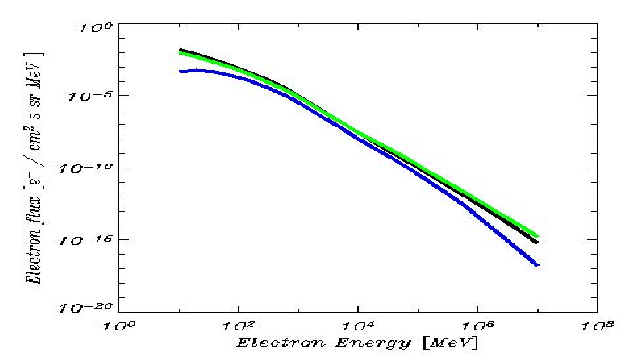



Next: Observing the Diffuse Emission
Up: Modeling the Gamma-Ray Emission
Previous: Interstellar Radiation Field
Contents
Cosmic Rays
One of the aims of gamma ray diffuse emission studies is to discriminate between cosmic ray models.
For this reason our gamma ray emissivity model can use as input both different analytical and numerical cosmic ray models
which have been developed in the last years.
The cosmic rays model assumed for the computation of the gamma emissivity, determines, in practice, the resulting gamma-ray spectrum.
The results presented in the following chapter are obtained by using the cosmic ray model given by the numerical code GALPROP [Strong et al., 2000], [Strong et al., 2004a] which derives the cosmic ray distribution accounting for physical processes like diffusion and energy losses.
We used the set of GALPROP input parameters, called ``HE'' in [Strong et al., 2000], namely, electron injection index: 1.7, proton injection index: 2.25, height of the cosmic-rays halo: 4 kpc, and diffusion coefficient of 6 

 The distribution of cosmic-rays sources chosen follows the supernovae remnants distribution.
This cosmic-rays model is able to reproduce the GeV excess, using a spectrum of cosmic electron harder than the local one.
The distribution of cosmic-rays sources chosen follows the supernovae remnants distribution.
This cosmic-rays model is able to reproduce the GeV excess, using a spectrum of cosmic electron harder than the local one.
Figure 2.7:
The energy distribution of the assumed electrons model. The black line is the distribution predicted for the Galaxy center (r=0, z=0), the green line is for the Galaxy outer region (r=30 kpc, z=0), while the blue line is for a region out of the plane (r=8.5 kpc z=3 kpc)
 |




Next: Observing the Diffuse Emission
Up: Modeling the Gamma-Ray Emission
Previous: Interstellar Radiation Field
Contents
Andrea Giuliani
2005-01-21

